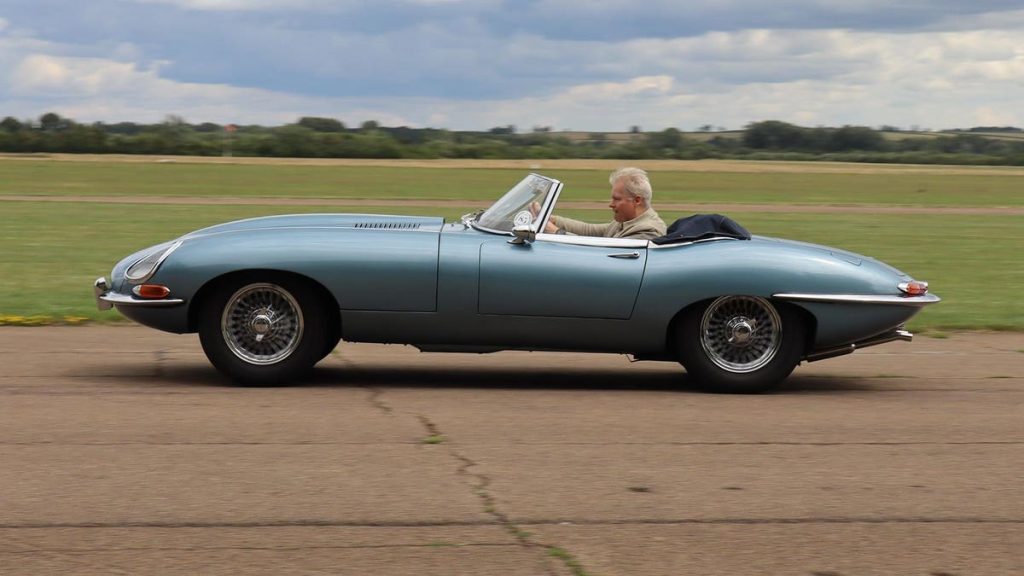The technology in new electric vehicles may be cutting edge, but that doesn’t always give them a sense of occasion to drive. Classic fossil fuel cars, in contrast, have bags of character, but can be an absolute nightmare to run as a daily driver. What if you could have a bit of both in one package? British EV conversion specialist Electrogenic reckons it has the answer with a series of drop-in kits to make electrifying your favorite classic car easier. I tried out the company’s latest creation – an electric Jaguar E-type. It could be the coolest EV I’ve ever driven.
Electrogenic Jaguar E-type Kit
The car I got my hands on was based on a 1962 Series 1 roadster, which had originally been equipped with a 3.8-liter straight six-cylinder engine. This originally offered 265bhp (198kW) and 325Nm (240 lb/ft) of torque, delivering 0-60 mph in 6.4 seconds (officially). It was the vehicle that Enzo Ferrari famously called “the most beautiful car ever made”. The Electrogenic version has lost none of its looks, but the internal combustion engine and gearbox have been removed, to be a replaced by an electric motor directly attached to the driveshaft, rather than through the gearbox as with many of the company’s previous conversions.
The new motor only delivers 160bhp (120kW), but the torque figure has nearly doubled to 630Nm (460 lb/ft). This means that acceleration has noticeably improved. With the new motor, the car can now hit 60mph in under six seconds and will feel even quicker off the line due to the lack of gears and immediate power. There’s a relatively small 43kWh battery, but that’s still enough for over 150 miles of real-world range. Despite the battery, the car is 90kg lighter than the original and has a better weight distribution, with 120kg less at the front and 30kg more at the back. E-types, particularly the V12 cars, were notoriously front-heavy, so this gives a welcome improvement in balance.
I got to put the electrified E-type through its paces at the Bicester Heritage track in the UK. This is a very short track with lots of corners and only a limited straight, so I wasn’t going much faster than 70mph at any point. The E-type kit offers three driving modes (Eco, Normal and Sport), and all the switchgear is original, so some of this has been repurposed for electrification. You turn the key to arm the system, press the original start button until an amber light indicates the motor is online, and then a slider chooses drive, reverse or neutral. The original handbrake is still evident.
Of course, after driving modern cars, being in a vehicle that doesn’t even have seatbelts takes some getting used to. Holding the steering wheel feels much more important for staying in your seat at speed. Although the E-type didn’t have the best reputation for handling, even the inline six, I found that I could push the Electrogenic version quite vigorously around corners. The acceleration felt potent, on par with the V12 E-type I was lucky to be taken out in once or twice in the mid-1980s.
The steering isn’t as immediate or precise as a modern car – the underlying vehicle is over 60 years old, after all. But it’s more than manageable despite the lack of power assistance. The car has disc brakes all round, and while you need to think a bit more about when to brake, so you do this early enough, the difference with a modern car is not so much as to be unsafe. I got used to it after about 10 minutes of vigorous driving. With the top down and the wind in my hair, the experience was exhilarating. I felt like Austin Powers in his Shaguar, only with slightly better teeth.
For comparison, I was able to take my own Tesla Model 3 Performance round the track for a few laps. Obviously, the steering, throttle and brake response were all in a different league. But it showed that the level of involvement with the Electrogenic E-type is still exceptional, albeit very different. As a car for local trips down the pub (within drinking limits) or to the golf course, there will be a sense of occasion every time. It’s a period experience, but that’s why you would have this conversion in the first place. This is a car you would look forward to driving, but with the reliability of electric instead of an unpredictable inline six that might not start when you want it to. You might miss the engine note, but with the top down there are plenty of other sensory inputs to enjoy, including the whine of the electric motor up front, which grew on me during my test drive.
Electrogenic now offers three E-type electrification packages. The one I drove is the base model, but there is a more powerful option with a 150kW (200bhp) motor delivering 840Nm (613 lb/ft) of torque plus a 48kWh battery. This enables 0-60mph in under five seconds and 160 miles of range. For the American market only (for the time being), there’s also a version with the more powerful motor and a 63kWh battery that offers over 200 miles of range. However, this involves greater chassis modifications, which are currently not allowed in the UK.
The cars offer DC rapid charging using CCS, enabling a 100% charge in around 45 minutes, although the one I tried only offered a US AC charging port because it was for an American customer with this requirement. The conversion kit costs a little over £80,000, but prices will vary, and in the USA it will be around $120,000. There will of course be the cost of a donor car on top of this, plus any refurbishment that might be required to that vehicle. The kit is compatible with Series 1 to 3 Jaguar E-types.
Electrogenic Drop-In Kits
Electrogenic’s concept with its kits is to provide an easier solution for electrifying a variety of common classics. The range kicked off with a Land Rover kit for agricultural conversions, prototyped at Glastonbury’s Worthy Farm. This has now been expanded to include Defender HV kit with up to 93kWh of battery capacity and CCS DC charging, for Land Rover 90, 110, 127 and 130 models. There are kits for Series II and III Land Rovers, plus a 911 kit for G-body or 964 Porsches. The most extreme version of the latter delivers 240kW (320bhp) of power and an almost unfeasible 3,900NM (2,848 lb/ft) of torque at the wheels, enabling 0-60mph in just 3.8 seconds. The 62kWh battery offers a range of up to 200 miles. Electrogenic has also been working with the UK’s Ministry of Defense in partnership with Babcock to convert some of its Land Rovers and Land Rover-based WMIK vehicles as a test of how electrification will perform out in the field.
These kits are meant to be installable by partner garages, of which there are seven globally, including three in the USA, with around five waiting in the wings. These partner garages receive installation training from Electrogenic, so they can then simply receive the electrification kit and fit it themselves up to the same standard.
However, there’s another drop-in kit in the wings aimed at classic Minis. This provides the motor, battery, and all the electronics pre-built onto a classic Mini front subframe, all for £15,000 plus ($19,000). This means the whole unit can be pre-tested before being shipped out to the customer, who then merely needs to replace the existing subframe, put the wheels back on, and wire everything up. This could even be something a keen enthusiast might do, although it’s still more aimed at professional garages. But the process will be much less involved, giving the potential for much wider adoption.
The basic mini kit will offer an 80-mile range from its 20kWh battery, which is ample for a city car. There will also be a larger battery option with 40kWh and 150 miles of range, but that won’t be such a seamless drop-in because it will require placing packs elsewhere in the car and the installation of the requisite cabling, which is a job only a properly qualified person should do. The larger battery option costs an additional £5000 ($6,000).
Electrifying classic cars comes in for a lot of negativity on social media, from people who think it’s a travesty. But there were over 70,000 Jaguar E-types built during its 1962-74 run, so it isn’t the rarest car in the world. Over five million classic Minis were built. Electrifying some of these means you will be more likely to see them on the roads, because they are much more practical and easier to live with. While you lose the engine noise and gear changing, that’s a fair trade for a car you can actually use regularly. As the founder and CEO of Electrogenic, Steve Drummond, said of his company: “We’re building cars that people want to drive – every day.” With the electrified Jaguar E-type, Electrogenic has done this for a British icon. You can imagine you’re back in the Swinging Sixties without the reliability downsides. Yeah, baby!
Read the full article here










